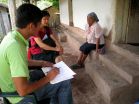(Press-News.org) A fecal microbiota transplant (FMT) not only cured a case of Clostridium difficile (C. diff) infection in a 66 year old man; it eliminated populations of multi-drug resistant organisms both in the patient's gastrointestinal tract, and several other body sites. This case report is published ahead of print April 15 in the Journal of Clinical Microbiology, a publication of the American Society for Microbiology.
The patient suffered from quadriplegia and multiple other conditions, requiring a ventilator, a feeding tube, and chronic foley catheterization. As a result of his complex medical needs, he was admitted to the intensive care unit at Scripps Mercy Hospital in San Diego, California. Within the first week, he was diagnosed with C. diff colitis, and treated with oral antibiotics. However, whenever the antibiotics were tapered, the C. diff rapidly relapsed. Concurrently, a number of multi-drug resistant organisms were isolated from the patient, which led to repeated infections.
Ultimately, the doctors suggested fecal microbiota transplant, and the patient's sister volunteered to be the donor, and passed the screening tests for infectious diseases and parasites. The doctors injected the material using a colonoscope, after discontinuation of antibiotics.
During the next two years and until the patient died, the C. diff never returned. Although methicillin-resistant Staphylococcus aureus (MRSA) did recolonize his urinary tract several months after the fecal transplant, the many other antibiotic-resistant microbes did not, despite his ongoing stay in the intensive care unit.
"The fecal microbiota transplant was successful in replenishing the patient's gut flora and stopping the releases of Clostridium difficile," said Nancy Crum-Cianflone, MD, an infectious disease specialist at Scripps Mercy Hospital, San Diego, CA. "Intriguingly, we additionally found that by letting the normal bacteria replenish his gastrointestinal tract, the resistant bacteria which had plagued him up to that point, disappeared from his body."
"Patients, especially those in long-term facilities, receive numerous courses of antibiotics that almost invariably result in both colonization and infections from multi-drug resistant organisms, and in the end with bacteria resistant to all antibiotics," said coauthor Gonzalo Ballon-Landa, MD, also an infectious disease specialist at Scripps Mercy Hospital. "This paper indicates that replenishing the normal gut flora and keeping these patients off antibiotics can result in the disappearance of multi-drug resistant organisms from the patients' bodies and thus potentially save their lives."
Clostridium difficile causes inflammation of the large intestine, resulting in diarrhea. It is particularly a problem in older adults receiving hospital care, and caused an estimated half million infections in 2011, with 29,000 deaths occurring within 30 days post-diagnosis, according to the US Centers for Disease Control and Prevention.
Fecal microbiota transplant uses fecal material, which is largely composed of microbiota, from a healthy donor, to provide "good bacteria" as a therapeutic agent. Fecal transplant has recently become an area of intense scientific investigation. It has been demonstrated to cure C. diff at a rate of 90 percent plus, vastly superior to antibiotic treatment, and investigators are testing it as a treatment for other conditions. A Medford, Massachusetts-based company, OpenBiome, now screens donors and ships stool to hospitals all over the US, and even abroad.
The rationale behind the technique lies in the fact that the healthy, intact human microbiome strongly resists invasion by pathogens because the good bacteria outcompete the bad ones for nutrition, binding sites, alteration of environmental conditions such as pH, and potentially host-microbiome interactions. A number of investigators are testing it against other conditions.
But fecal microbiota transplant is not new. Evidence exists that "yellow soup" was used against intestinal infections 1,700 years ago, and fecal transplant has been used sporadically for pseudomembranous colitis since the 1950s.
INFORMATION:
The American Society for Microbiology is the largest single life science society, composed of over 39,000 scientists and health professionals. ASM's mission is to advance the microbiological sciences as a vehicle for understanding life processes and to apply and communicate this knowledge for the improvement of health and environmental and economic well-being worldwide.
Imagine taking strands of DNA - the material in our cells that determines how we look and function - and using it to build tiny structures that can deliver drugs to targets within the body or take electronic miniaturization to a whole new level.
While it may still sound like science fiction to most of us, researchers have been piecing together and experimenting with DNA structures for decades. And, in recent years, work by scientists such as McGill University chemistry professor Hanadi Sleiman has moved the use of man-made DNA structures closer to a variety of real-world ...
A study of survival rates in trauma patients following health insurance reform in Massachusetts found a passing increase in adjusted mortality rates, an unexpected finding suggesting that simply providing insurance incentives and subsidies may not improve survival for trauma patients, according to a report published online by JAMA Surgery.
Massachusetts introduced health care reform in 2006 to expand health insurance coverage and improve outcomes. Some previous research has suggested improved survival rates following injury in patients with insurance. But the relationship ...
This news release is available in French. Montreal, May 6, 2015 -- Plans for summer holidays are already taking shape. But before jetting off for some fun in the sun, many travellers will have to cope with long delays on the airport runway.
Thanks to new research from Concordia University, however, that time spent twiddling your thumbs on the tarmac could be significantly reduced.
In a new study, forthcoming in the American Institute of Aeronautics and Astronautics' Journal of Aircraft, Concordia mechanical engineering professor Georgios Vatistas describes a new ...
A Stirling scientist who discovered a new Scottish flower has made an unexpected second finding which provides unique insight into our understanding of evolution.
Dr Mario Vallejo-Marin, a Plant Evolutionary Biologist at the University of Stirling, first unearthed a new species of monkeyflower on the bank of a stream in South Lanarkshire, Southern Scotland in 2012.
A subsequent expedition two years later led Dr Vallejo-Marin to locate the impressive yellow flower some 350 miles north, near Stromness on the Orkney Islands off the north coast of Scotland.
"Orkney was ...
There are now over 80,000 apps marketed as "educational" in the Apple app store, the majority of which are targeted towards children and even babies. Parents are led to believe that these apps provide real learning opportunities for their children, but scientific research suggests that many of the apps are nothing more than digital candy.
"Many apps marketed as 'educational' are basically the equivalent of sugary foods," says Kathy Hirsh-Pasek of Temple University, co-author on a new report investigating educational apps. "At best, most of these apps will do no harm; ...
NEW YORK (May 6, 2015) -- To fence or not to fence? That is the question facing conservationists concerned with barriers that keep wildlife in and people out.
According to a new study by the Zoological Society of London (ZSL), Wildlife Conservation Society (WCS) and other groups, appearing in April 20 edition of the Journal of Applied Ecology, new policies must be developed before fences are erected - particularly in dryland ecosystems where mobility is essential for both humans and wildlife.
Some nations are considering fences as a means to protect remnant wildlife ...
This news release is available in German.
An X-ray study carried out at DESY allows to improve the quality of chocolate. The study offers new insights into the formation of fat bloom, an unwelcome white layer that occasionally forms on chocolate. "Although fat blooming is perfectly harmless, it causes millions in damage to the food industry as a result of rejects and customer complaints," explains the main author of the study, Svenja Reinke, from the Hamburg University of Technology (TUHH). "Despite this well known quality issue, comparatively little has been known ...
(BOSTON) - Increasingly, scientists across the world and in the Unites States are reporting new and groundbreaking innovations in biotechnology with transformative implications in human health and environmental sustainability. Examples range from synthetically created, metabolically-engineered bacteria for the sustainable production of fuel to gene editing therapies that could one day help in the prevention and treatment of a large number of human diseases.
While these technologies are developed in laboratories, researchers are not only giving utmost consideration to ...
New Haven, Conn. - Convincing a large group of people to change its behavior is no popularity contest, a new study shows.
In a novel experiment, researchers found that certain public health interventions work best when key "influencers" in a face-to-face social network are exposed to the program. What's surprising, they say, is that those key influencers are not the most socially connected people in the network.
Furthermore, those individuals can be identified through a survey method informed by network structure rather than costly and time-consuming social network mapping. ...
Maybe it's not such a dog-eat-dog world after all. A clever combination of two different types of computer simulations enabled a group of Illinois researchers to uncover an unexpectedly cooperative group dynamic: the spontaneous emergence of resource sharing among individuals in a community. Who were the members of this friendly, digitally represented collective? Escherichia coli, rod-shaped bacteria found in the digestive systems of humans and many other animals.
The finding, initially predicted by mathematical models and then confirmed through empirical testing, was ...



